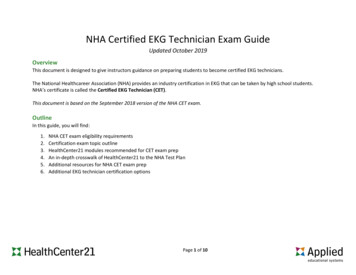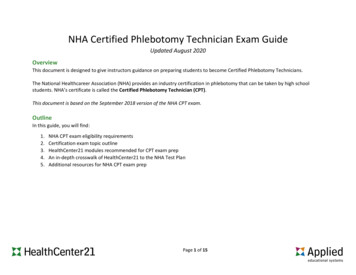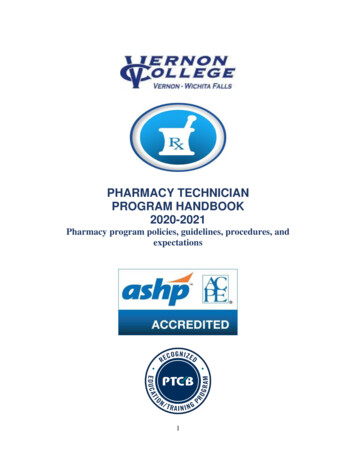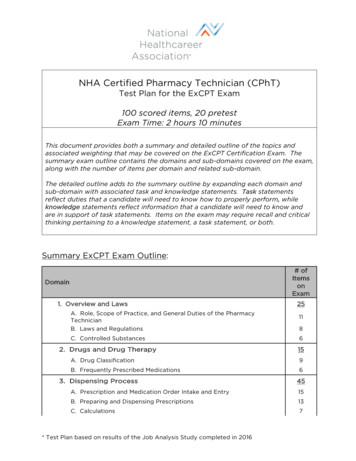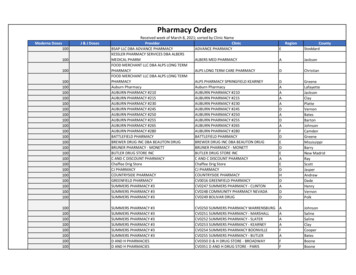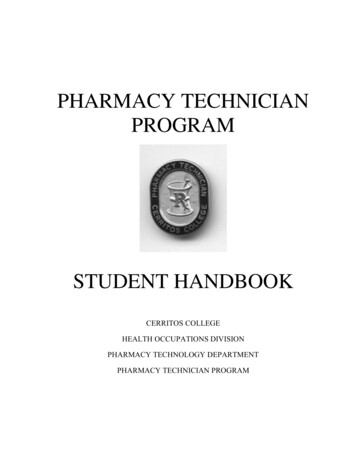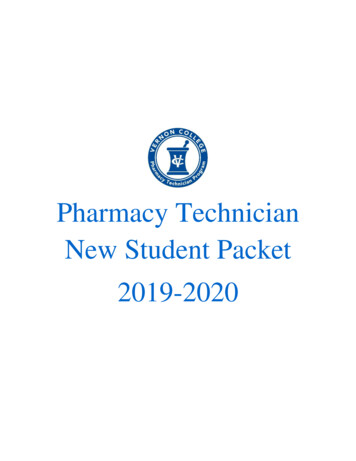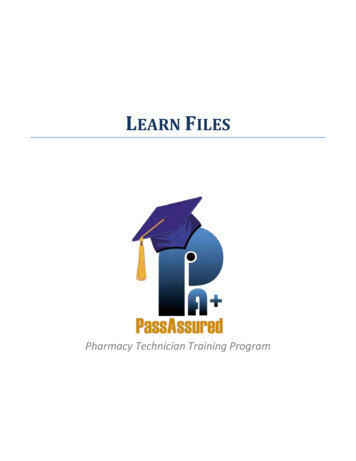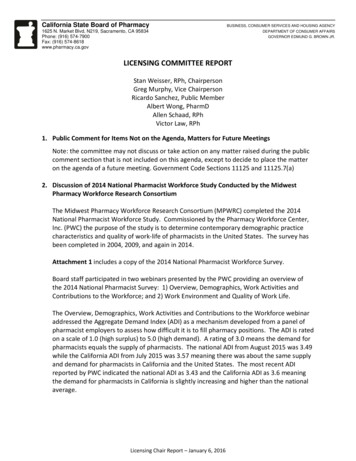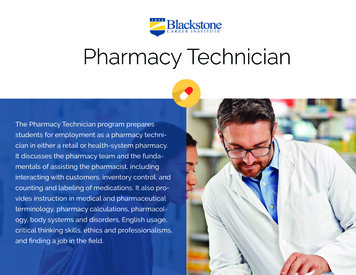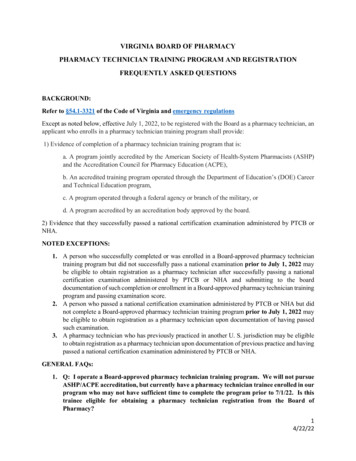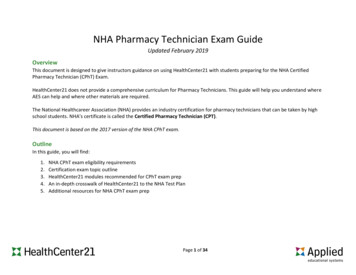
Transcription
NHA Pharmacy Technician Exam GuideUpdated February 2019OverviewThis document is designed to give instructors guidance on using HealthCenter21 with students preparing for the NHA CertifiedPharmacy Technician (CPhT) Exam.HealthCenter21 does not provide a comprehensive curriculum for Pharmacy Technicians. This guide will help you understand whereAES can help and where other materials are required.The National Healthcareer Association (NHA) provides an industry certification for pharmacy technicians that can be taken by highschool students. NHA’s certificate is called the Certified Pharmacy Technician (CPT).This document is based on the 2017 version of the NHA CPhT exam.OutlineIn this guide, you will find:1.2.3.4.5.NHA CPhT exam eligibility requirementsCertification exam topic outlineHealthCenter21 modules recommended for CPhT exam prepAn in-depth crosswalk of HealthCenter21 to the NHA Test PlanAdditional resources for NHA CPhT exam prepPage 1 of 34
1. Eligibility Requirements for the NHA CPhT ExamIn order to sit for the NHA CPhT exam, students must have all of the following:1. A high school diploma or GED equivalency2. Successful completion of a CPhT training programHigh school students may earn provisional certificates prior to graduation. Key information to note includes:1. High school students must be within 60 days of meeting graduation requirements2. High school students are not eligible for the exam in some states (Arizona)3. High school students will receive provisional certifications4. A provisional certificate expires 12 months from the exam date5. After graduation, graduates may apply to convert the active provisional certificate to a full certificate2. NHA CPhT Exam Topic OutlineThe exam measures knowledge by asking questions 100 multiple choice questions, across four domains.1. Overview and Laws (Total 25 Questions)a. Role, Scope of Practice, and General Duties (11 Questions)b. Laws and Regulations (8 Questions)c. Controlled Substances (6 Questions)2. Drugs and Drug Therapy (Total 15 Questions)a. Drug Classifications (9 Questions)b. Frequently Prescribed Medications (6 Questions)3. Dispensing Process (Total 45 Questions)a. Prescription and Medication Order Intake and Entry (15 Questions)b. Preparing and Dispensing Prescriptions (13 Questions)c. Calculations (7 Questions)4. Medical Safety and Quality Assurance (Total 15 Questions)For more details on the NHA CPhT exam content, see www.nhanow.comPage 2 of 34
3. HealthCenter21 Modules Recommended for CPhT Exam PrepHealthCenter21 has many modules that will help your students prepare for the CPhT exam. The modules cover the foundationalknowledge, specified on the test plan as “Supporting Knowledge.” HealthCenter21 does not provide curriculum on processes andprocedures related to Pharmacy Technician job duties.The modules that cover CPhT Supporting Knowledge are: Anatomy & PhysiologyEmergency CareHealth Information TechnologyInfection ControlInsurance & CodingLegal & Ethical ResponsibilitiesMedical Office AssistantMedical RecordsMedical TerminologyPharmacologyPhysical ExaminationsSafety PrecautionsSpecial PopulationsThe Health AssistantWellness & NutritionSee the next page for an in-depth crosswalk between HealthCenter21 and the NHA CPhT Test Plan.The coverage of each topic within HealthCenter21 is broken down as being High, Medium, Low, or Not Covered.Page 3 of 34
4. Crosswalk Between NHA Pharmacy Technician Test Plan & HealthCenter21Overview and LawsA. Role, Scope of Practice, and General Duties ofthe Pharm Tech1. Differentiate between tasks that may be performed by apharmacy technician and those that must be performed by apharmacist.Supporting Knowledgea. Role of the pharmacy technicianb. Role of the pharmacist (for example: verification ofprescriptions, requirements for counseling)c. Scope of pharmacy technician practiced. Pharmacy operations and process flowe. Pharmacy practice settings (for example: community,institutional, in-patient, long-term care, compounding)2. Maintain pharmacy security (for example: secure medications,prevent unauthorized access).Supporting Knowledgea. Pharmacy security measures (for example: sign off, barriers)b. Authorized personnel (including law enforcement), access topharmacy areas, identification requirements, level ofsupervision3. Assist pharmacist in medication reconciliation.Supporting Knowledgea. Purpose and benefits of medication reconciliation and pharmacytechnician's role in medication reconciliationb. Medical terminology (for example, pharmacy abbreviations,prefixes, suffixes, root words, combining vowels)c. Communication methods and strategies (for example,interviewing techniques, non-verbal cues, communication styles)HealthCenter21 LocationHealthCenter21 CoverageNot CoveredNot CoveredNot CoveredNot CoveredA - Not CoveredB - Module: Medical TerminologyUnits 1 & 2B - HighC – Not CoveredC - HighPage 4 of 34
4. Assist pharmacist in medication therapy management.Supporting Knowledgea. Purpose and benefits of medication therapy management(MTM) and pharmacy technician's role in MTMb. Medical terminology (for example: pharmacyabbreviations, prefixes, suffixes, root words, combiningvowels)c. Communication methods and strategies (for example:interviewing techniques, nonverbal cues, communicationstyles)5. Assist patient in selecting compliance aids and devices.Supporting Knowledgea. Benefits of compliance aids and devices (for example:lockboxes, timers, personalized automatic dispensing devices)b. Communication methods and strategies (for example:interviewing techniques, nonverbal cues, communicationstyles)6. Interpret basic medical terminology commonly used in thepharmacy.Supporting Knowledgea. Medical terminology (for example: pharmacy abbreviations,prefixes, suffixes, root words, combining vowels)7. Tailor communications to different audiences, including patients,caregivers, staff, and health care professionals.Supporting KnowledgeCommunication methods and strategies (for example:interviewing techniques, nonverbal cues, communicationstyles)8. Interact with customers and patients in a professional manner,including internal and external customers.Supporting Knowledgea. Communication methods and strategies (for example:interviewing techniques, nonverbal cues, communicationstyles)A – Not CoveredB - HighB - Module: Medical TerminologyUnits 1 & 2C – Not CoveredNot CoveredNot CoveredModule: Medical TerminologyUnits 1 & 2HighNot CoveredNot CoveredNot CoveredNot CoveredPage 5 of 34
9. Confirm final product verification has been completed bypharmacist prior to release to patient.Supporting Knowledgea. Role of the pharmacy technicianb. Role of the pharmacist (for example: verification ofprescriptions, requirements for counseling)10. Assist the pharmacist in managing inventory by placing,receiving, verifying, rotating, and stocking orders.Supporting Knowledgea. Pharmacy operations and process flowb. Components of drug pricingc. Ordering and inventory management methods (for example:PAR levels, just in time ordering, rotating inventory, fastmovers)11. Store medications following manufacturers’ requirements (forexample: light, temperature, humidity).Supporting Knowledgea. Pharmacy operations and process flowb. Storage requirements for medications12. Identify and remove expired products in a pharmacy’s inventory.Supporting Knowledgea. Pharmacy operations and process flowb. Ordering and inventory management methods (for example:PAR levels, just in time ordering, rotating inventory, fastmovers)13. Identify and remove recalled products from inventory.Supporting Knowledgea. Pharmacy operations and process flowb. Classes of recalls and required actionsc. Ordering and inventory management methods (for example:PAR levels, just in time ordering, rotating inventory, fastmovers)d. Disposal methodsNot CoveredNot CoveredNot CoveredNot CoveredA – Not CoveredB – Module: PharmacologyUnit 2, Lesson 2B - MediumNot CoveredNot CoveredA & B – Not CoveredC & D – Module: PharmacologyUnit 2, Lesson 1Page 6 of 34C & D - High
14. Dispose of medications based on product-specific requirements.Supporting Knowledgea. Pharmacy operations and process flowb. Disposal methodsc. Material Safety Data Sheets (MSDS)/Safety Data Sheets (SDS)15. Access and use references and resources as needed to performjob duties.Supporting Knowledgea. USP Standardsb. Orange Bookc. Red Bookd. Clinical information sources (for example: Drug Facts andComparisons, Micromedex, Lexicomp, Up to Date)e. Ident-a-drugf. Handbook on Injectablesg. State Board of Pharmacy regulationsh. Poison Control CentersA – Not CoveredB – Module: PharmacologyUnit 2, Lesson 1B – HighC – Module: Safety PrecautionsUnit 3, Lesson 3A – G - Not CoveredC - HighH – Module: Emergency CareUnit 5, Lesson 2H - HighPage 7 of 34
Overview and LawsB. Laws and Regulations1. Comply with federal laws and regulations applicable to pharmacypractice.Supporting Knowledgea. Health Insurance Portability and Accountability Act (HIPAA)b. Combat Methamphetamine Epidemic Act of 2005 (CMEA)c. Drug Listing Act of 1972 (including elements of the NDC)d. Food and Drug Act of 1906e. Omnibus Budget Reconciliation Act of 1990 (OBRA 90)f. Durham-Humphrey Amendmentg. Food, Drug, and Cosmetic Acth. Drug Supply Chain Security Act (DSCSA) a.k.a. Track and Tracei. Laws related to bioequivalencej. Poison Prevention Packaging Act (PPPA)Kefauver-HarrisAmendmentk. Orphan Drug Actl. Medicare Modernization Actm. Centers for Medicare and Medicaid Services (CMS)n. Anabolic Steroid Acto. Safe handling and disposal practices for hazardous drugs (USPp. 800 )q. Laws related to non-controlled substances when handlingrefills and/or partial filling of prescriptions2. Maintain HIPAA compliance while communicating and disclosinginformation with patients, caregivers, health care professionals, andothers.Supporting Knowledgea. Health Insurance Portability and Accountability Act (HIPAA)3. Comply with HIPAA requirements regarding collection, storage,and disposal of patient information.Supporting Knowledgea. Health Insurance Portability and Accountability Act (HIPAA)HealthCenter21 LocationA – Module: Medical Office AssistantUnit 3, Lesson 1HealthCenter21 CoverageA - HighB – D – Not CoveredE – Module: Special PopulationsUnit 2, Lesson 3E – MediumF – M – Not CoveredN – Module: Insurance and CodingUnit 2, Lessons 1 – 2N – HighO – Not CoveredP – Module: PharmacologyUnit 2, Lesson 1P – HighQ – Module: PharmacologyUnit 2, Lesson 1Q – HighModule: Health Information TechnologyUnit 3, Lessons 1 – 3HighModule: Legal & Ethical ResponsibilitiesUnit 2, Lessons 1 – 4Module: Medical RecordsUnit 4, Lessons 1 - 3Page 8 of 34High
4. When filling prescriptions or medication orders, comply withapplicable laws and regulations.Supporting Knowledgea. Health Insurance Portability and Accountability Act (HIPAA)b. Combat Methamphetamine Epidemic Act of 2005 (CMEA)c. Drug Listing Act of 1972 (including elements of the NDC)d. Food and Drug Act of 1906e. Omnibus Budget Reconciliation Act of 1990 (OBRA 90)f. Durham-Humphrey Amendmentg. Food, Drug, and Cosmetic Acth. Laws related to bioequivalencei. Poison Prevention Packaging Act (PPPA)j. Medicare Modernization Actk. Centers for Medicare and Medicaid Services (CMS)l. Anabolic Steroid Actm. Safe handling and disposal practices for hazardous drugs (USP 800 )n. Laws related to non-controlled substances when handlingrefills and/or partial filling of prescriptionso. Organizations/regulators related to pharmacy practice (forexample: OSHA, The Joint Commission, FDA)A – Module: Medical Office AssistantUnit 3, Lesson 1A – HighB & C – Not CoveredD – Module: Safety PrecautionsUnit 1, Lesson 3D – MediumE – Module: Special PopulationsUnit 2, Lesson 3E – MediumF – J – Not CoveredK – Module: Insurance and CodingUnit 2, Lesson 2K – MediumL – Not CoveredM & N – Module: PharmacologyUnit 2, Lesson 1M & N – HighO – Module: Safety PrecautionsUnit 1, Lesson 3O - HighPage 9 of 34
5. Follow laws and regulations for non-controlled substances whenhandling refills and/or partial filling of prescriptions.Supporting Knowledgea. Health Insurance Portability and Accountability Act (HIPAA)b. Combat Methamphetamine Epidemic Act of 2005 (CMEA)c. Drug Listing Act of 1972 (including elements of the NDC)d. Food and Drug Act of 1906e. Omnibus Budget Reconciliation Act of 1990 (OBRA 90)f. Durham-Humphrey Amendmentg. Food, Drug, and Cosmetic Acth. Laws related to bioequivalencei. Poison Prevention Packaging Act (PPPA)j. Medicare Modernization Actk. Centers for Medicare and Medicaid Services (CMS)l. Anabolic Steroid Actm. Safe handling and disposal practices for hazardous drugs (USP 800 )n. Laws related to non-controlled substances when handlingrefills and/or partial filling of prescriptionso. Organizations/regulators related to pharmacy practice (forexample: OSHA, The Joint Commission, FDA)6. Package prescription medications in child-resistant containers orother approved containers as required.Supporting Knowledgea. Food, Drug, and Cosmetic Actb. Poison Prevention Packaging Act (PPPA)7. Comply with OSHA regulations for disposal of sharps.Supporting Knowledgea. Organizations/regulators related to pharmacy practice (forexample: OSHA, The Joint Commission, FDA)A – Module: Medical Office AssistantUnit 3, Lesson 1A – HighB – C – Not CoveredD – Module: Safety PrecautionsUnit 1, Lesson 3D – HighE – Module: Special PopulationsUnit 2, Lesson 3E - HighF – J – Not CoveredK – Module: Insurance and CodingUnit 2, Lesson 2K – HighL – Not CoveredM - O – Module: PharmacologyUnit 2, Lesson 1M – O – HighNot CoveredNot CoveredModule: The Health AssistantUnit 4, Lesson 2HighPage 10 of 34
8. Comply with laws related to monitoring and reporting fraud,waste, and abuse.Supporting Knowledgea. Combat Methamphetamine Epidemic Act of 2005 (CMEA)b. Drug Supply Chain Security Act (DSCSA) a.k.a. Track and Tracec. Medicare Modernization Actd. Centers for Medicare and Medicaid Services (CMS)e. Anabolic Steroid Actf. Organizations/regulators related to pharmacy practice (forexample: OSHA, The Joint Commission, FDA)Module: The Health AssistantUnit 4, Lesson 3A – C – Not CoveredD – Module: Insurance & CodingUnit 2, Lesson 2D – HighE – Not CoveredF – Module: PharmacologyUnit 2, Lesson 1Page 11 of 34F - High
9. Follow record-keeping and retention procedures per federalrequirements.Supporting Knowledgea. Health Insurance Portability and Accountability Act (HIPAA)b. Combat Methamphetamine Epidemic Act of 2005 (CMEA)c. Drug Listing Act of 1972 (including elements of the NDC)d. Food and Drug Act of 1906e. Omnibus Budget Reconciliation Act of 1990 (OBRA 90)f. Durham-Humphrey Amendmentg. Food, Drug, and Cosmetic Acth. Drug Supply Chain Security Act (DSCSA) a.k.a. Track and Tracei. Laws related to bioequivalencej. Poison Prevention Packaging Act (PPPA)k. Kefauver-Harris Amendmentl. Orphan Drug Actm. Medicare Modernization Actn. Centers for Medicare and Medicaid Services (CMS)o. Anabolic Steroid Actp. Safe handling and disposal practices for hazardous drugs (USP 800 )q. Laws related to non-controlled substances when handlingrefills and/or partial filling of prescriptionsr. Organizations/regulators related to pharmacy practice (forexample: OSHA, The Joint Commission, FDA)Module: PharmacologyUnit 2, Lesson 1A – Module: Medical Office AssistantUnit 3, Lesson 1A – HighB – Not CoveredC – Module: PharmacologyUnit 3, Lesson 2C – MediumD – Module: Safety PrecautionsUnit 1, Lesson 3D – HighE – Module: Special PopulationsUnit 2, Lesson 3E – HighF – M – Not CoveredN – Module: Medical Office Assistant,Insurance & CodingUnit 3, Lesson 1N – HighO – Not CoveredP & Q – Module: PharmacologyUnit 2, Lesson 1R – Safety PrecautionsUnit 1, Lesson 1Page 12 of 34P & Q – HighR - High
Overview and LawsC. Controlled Substances1. Differentiate among the controlled substances schedules and thedrugs within them.Supporting Knowledgea. Controlled Substances Act (CSA)b. Drug Enforcement Administration (DEA) for controlledsubstancesc. Schedules of controlled substances and drugs within themd. Exempt narcoticse. Prescription requirements for controlled substancesf. Elements of and formula for DEA numberg. DEA forms (for example: 41, 106, 222)h. Procedures for ordering, receiving, storing, and disposing ofi. controlled substances2. Identify elements needed to verify the validity of DEA number.Supporting Knowledgea. Elements of and formula for DEA number3. Verify, on intake, required information is on prescription forcontrolled substance.Supporting Knowledgea. Controlled Substances Act (CSA)b. Schedules of controlled substances and drugs within themc. Prescription requirements for controlled substancesd. Elements of and formula for DEA numbere. Expiration dates and refills for controlled substancesf. Laws, regulations, and processes to transfer controlledsubstances between pharmaciesg. Diversion and prescription monitoring programsHealthCenter21 LocationHealthCenter21 CoverageA – C – Module: PharmacologyUnit 2, Lesson 1A – C – HighD – Not CoveredE - H – Module: PharmacologyUnit 2, Lesson 1E – HighF – LowG – H – HighModule: PharmacologyUnit 2, Lesson 1LowA – C – Module: PharmacologyUnit 1, Lesson 1A – C – HighD – Not CoveredE – Module: PharmacologyUnit 1, Lesson 1F – G – Not CoveredPage 13 of 34E – High
4. Comply with laws and regulations when filling, partial filling, andrefilling prescriptions for controlled substances.Supporting Knowledgea. Controlled Substances Act (CSA)b. Schedules of controlled substances and drugs within themc. Prescription requirements for controlled substancesd. Elements of and formula for DEA numbere. Expiration dates and refills for controlled substancesf. Emergency filling proceduresg. Laws, regulations, and processes to transfer controlledsubstances between pharmaciesh. Laws, regulations, and processes to transfer prescriptions forcontrolled substances between pharmaciesi. Tracking requirements for perpetual inventory of controlledsubstancesj. Diversion and prescription monitoring programs5. File all classes of prescriptions appropriately.Supporting Knowledgea. Controlled Substances Act (CSA)b. Drug Enforcement Administration (DEA) for controlledsubstancesc. Filing requirementsA – E – Module: PharmacologyUnit 1, Lesson 1A – C – HighD – MediumE – HighF – H – Not CoveredI – Module: PharmacologyUnit 1, Lesson 1I – HighJ – Not CoveredModule: PharmacologyUnit 1, Lesson 1Page 14 of 34High
6. Comply with federal laws pertaining to the handling of Schedule V(exempt narcotics) and regulated (BTC) non-prescription products.Supporting Knowledgea. Controlled Substances Act (CSA)b. Drug Enforcement Administration (DEA) for controlledsubstancesc. Schedules of controlled substances and drugs within themd. Exempt narcoticse. Filing requirementsf. Laws, regulations, and processes to transfer controlledsubstances between pharmaciesg. Laws, regulations, and processes to transfer prescriptions forcontrolled substances between pharmaciesh. Procedures for ordering, receiving, storing, and disposing ofcontrolled substancesi. Tracking requirements for perpetual inventory of controlledsubstancesj. Diversion and prescription monitoring programs7. Order, store, and maintain inventory of controlled substances inaccordance with CSA.Supporting Knowledgea. Controlled Substances Act (CSA)b. Drug Enforcement Administration (DEA) for controlledsubstancesc. DEA forms (for example: 41, 106, 222)d. Procedures for ordering, receiving, storing, and disposing ofcontrolled substancese. Tracking requirements for perpetual inventory of controlledsubstancesf. Diversion and prescription monitoring programsA – C – Module: PharmacologyUnit 1, Lesson 1A – C – HighD – G – Not CoveredH – I – Module: PharmacologyUnit 2, Lesson 1H – I – HighJ – Not CoveredA – B – Module: PharmacologyUnit 1, Lesson 1A – B – HighC – Not CoveredD – Module: PharmacologyUnit 1, Lesson 1D – HighE – Module: Medical AssistantUnit 2, Lesson 1E - HighF – Not CoveredPage 15 of 34
Drugs and Drug TherapyA. Drug Classification1. Differentiate among therapeutic classes of drugs.Supporting Knowledgea. Drug classes (for example: analgesics, dermatologics)b. Drug class abbreviations (for example: NSAID, SSRI, ARB, ACE)2. Differentiate among various dosage forms.Supporting Knowledgea. Dosage forms (for example: tablets, capsules, ointments, creams,controlled-release, immediate-release, elixir, suspension)3. Differentiate among various routes of administration.Supporting Knowledgea. Routes of administration (for example: topical, parenteral, oral)4. Match common prescription/legend medications with theirindications.Supporting Knowledgea. Indications for frequently prescribed medicationsb. Basic body systems and disease statesc. Prescription/legend medications and their indications5. Match common over-the-counter (OTC) products with theirindications.Supporting Knowledgea. Basic body systems and disease statesb. Over-the-counter (OTC) medications and their indications6. Match common behind-the-counter (BTC) products with theirindications.Supporting Knowledgea. Basic body systems and disease statesb. Behind-the-counter (BTC) medications and their indicationsHealthCenter21 LocationHealthCenter21 CoverageModule: PharmacologyUnit 1, Lesson 1Unit 2, Lesson 2HighModule: Medical MathematicsUnit 4, Lesson 2MediumModule: PharmacologyUnit 3, Lesson 2HighA & C – Not CoveredB – Module: Anatomy & PhysiologyB - HighA – Module: Anatomy & PhysiologyA – HighB – Not CoveredA – Module: Anatomy & PhysiologyB – Not CoveredPage 16 of 34A – High
Drugs and Drug TherapyB. Frequently Prescribed Medications1. Match brand and generic names of commonly used prescriptionmedications.Supporting Knowledgea. Drug Topics Top 200 medications (by prescription volume peryear)b. Brand and generic medication namesc. Therapeutic equivalence2. Differentiate between side effects and adverse drug reactions.Supporting Knowledgea. Effects and side-effects of pharmacotherapy3. Differentiate between contraindications and drug interactions.Supporting Knowledgea. Drug interactions (for example: drug-drug, drug-food, drugOTC)4. Recognize physical interactions and incompatibilities in thepreparation of compounded and parenteral medications.Supporting Knowledgea. Physical interactions and incompatibilities5. Recognize common vaccines and immunization schedules.Supporting Knowledgea. Vaccine and immunization schedulesHealthCenter21 LocationHealthCenter21 CoverageA & C – Not CoveredB – Module: Wellness & NutritionUnit 2, Lesson 1B - HighModule: PharmacologyUnit 1, Lesson 2MediumModule: PharmacologyUnit 1, Lesson 2MediumNot CoveredNot CoveredModule: Physical ExaminationsUnit 3, Lesson 2HighPage 17 of 34
Dispensing ProcessA. Prescription and Medication Order Intake andEntry1. Analyze a prescription or medication order for completeness andobtainmissing information.Supporting Knowledgea. Required components of a prescriptionb. Types/formats of prescription/medication orders (forexample: telephone, facsimile, electronic prescription orders,computerized physician order entry)c. Providers with prescribing authority (what types of providerscan prescribe what types of medications)d. Allowable refills based on prescription drug type and drugclasse. National Provider Identifier (NPI)f. Purpose and use of SIG codes/pharmacy abbreviationsg. Institute for Safe Medication Practices error-proneabbreviations listh. DAW codes and their usesHealthCenter21 LocationA & B – Module: PharmacologyUnit 2, Lessons 1 – 2HealthCenter21 CoverageA & B – HighC – Not CoveredD – Module: PharmacologyUnit 2, Lesson 1D – HighE – Module: Insurance & CodingUnit 4, Lesson 2E – MediumF – Module: PharmacologyUnit 2, Lesson 2F – HighG & H – Not CoveredPage 18 of 34
2. Process prescription orders (for example: telephone, facsimile,and electronic).Supporting Knowledgea. Required components of a prescriptionb. Types/formats of prescription/medication orders (forexample: telephone, facsimile, electronic prescription orders,computerized physician order entry)c. Providers with prescribing authority (what types of providerscan prescribe what types of medications)d. Allowable refills based on prescription drug type and drugclasse. Components of a patient profilef. National Provider Identifier (NPI)g. Purpose and use of SIG codes/pharmacy abbreviationsh. Institute for Safe Medication Practices error-proneabbreviations listi. DAW codes and their usesj. Appropriate responses to electronic alertsk. Components required to process a third-party claim (forexample: BIN, PCN, prescription group code, person code)l. Coordination of benefitsm. Types of formulariesn. Types of third-party rejections (for example: duplicatetherapy, high dose, prior authorization, missing diagnosiscode)o. Tiered copaysp. Types of coverage (for example: Medicare, Medicaid,workers’ compensation, HMO, patient assistance programs)q. Drug utilization reviews/Drug utilization evaluationsA & B – Module: PharmacologyUnit 2, Lessons 1 – 2A & B – HighC – Not CoveredD – Module: PharmacologyUnit 2, Lesson 1D – HighE – Not CoveredF - Module: PharmacologyUnit 2, Lesson 2F - HighG – Module: PharmacologyUnit 2, Lesson 2G – HighH – J – Not CoveredK – Module: Insurance & CodingUnit 4, Lesson 2K – HighL & M – Not CoveredN – Module: Insurance & CodingUnit 4, Lesson 2N – HighO – Not CoveredP – Module: Insurance & CodingUnit 4, Lessons 1 – 4Q – Not CoveredPage 19 of 34P – High
3. Process prescription refill authorization requests fromprescribers.Supporting Knowledgea. Providers with prescribing authority (what types of providerscan prescribe what types of medications)b. Allowable refills based on prescription drug type and drugclass4. Obtain information for the patient profile from patients, such asdemographics, medication history (including OTCs and herbalsupplements), health conditions, concurrent medications, allergies,and third-party payers.Supporting Knowledgea. Components of a patient profileb. Components required to process a third-party claim (forexample: BIN, PCN, prescription group code, person code)c. Types of coverage (for example: Medicare, Medicaid,workers’ compensation, HMO, patient assistance programs)5. Enter and maintain electronic patient profiles.Supporting Knowledgea. Components of a patient profileb. Components required to process a third-party claim (forexample: BIN, PCN, prescription group code, person code)c. Types of coverage (for example: Medicare, Medicaid,workers’ compensation, HMO, patient assistance programs)6. Identify and input third-party payer identifier numbers.Supporting Knowledgea. Components required to process a third-party claim (forexample: BIN, PCN, prescription group code, person code)b. Coordination of benefitsc. Types of coverage (for example: Medicare, Medicaid,workers’ compensation, HMO, patient assistance programs)A – Not CoveredB – Module: PharmacologyUnit 2, Lesson 1B - HighA – Module: Health InformationTechnologyUnit 2, Lesson 1A – MediumB – Module: Insurance & CodingUnit 4, Lesson 2B – HighC – Module: Insurance & CodingUnit 2, Lessons 1 - 4C - HighA – Module: Health InformationTechnologyUnit 2, Lesson 1A – MediumB – Module: Insurance & CodingUnit 4, Lesson 2B – HighC – Module: Insurance & CodingUnit 2, Lessons 1 - 4A – Module: Insurance & CodingUnit 4, Lesson 2C – HighA – HighB – Not CoveredC – Module: Insurance & CodingUnit 2, Lessons 1 - 4Page 20 of 34C - High
7. Process third-party prescriptions (for example: coordination ofbenefits, rejections, copays, prior authorizations).Supporting Knowledgea. DAW codes and their usesb. Appropriate responses to electronic alertsc. Components required to process a third-party claim (forexample: BIN, PCN, prescription group code, person code)d. Coordination of benefitse. Types of formulariesf. Types of third-party rejections (for example: duplicatetherapy, high dose, prior authorization, missing diagnosiscode)g. Tiered copaysh. Types of coverage (for example: Medicare, Medicaid,workers’ compensation, HMO, patient assistance programs)8. Communicate with patients, providers, and/or third-party payersabout prescription coverage.Supporting Knowledgea. Appropriate responses to electronic alertsb. Components required to process a third-party claim (forexample: BIN, PCN, prescription group code, person code)c. Coordination of benefitsd. Types of formulariese. Types of third-party rejections (for example: duplicatetherapy, high dose, prior authorization, missing diagnosiscode)f. Tiered copaysg. Types of coverage (for example: Medicare, Medicaid,workers’ compensation, HMO, patient assistance programs)h. Drug utilization reviews/Drug utilization evaluationsA & B – Not CoveredC - Module: Insurance & CodingUnit 4, Lesson 2C – HighD & E – Not CoveredF - Module: Insurance & CodingUnit 4, Lesson 2F – HighG – Not CoveredH - Module: Insurance & CodingUnit 2, Lessons 1 - 4H - HighA – Not CoveredB - Module: Insurance & CodingUnit 4, Lesson 2B – HighC & D – Not CoveredE - Module: Insurance & CodingUnit 4, Lesson 2E – HighF – Not CoveredG - Module: Insurance & CodingUnit 4, Lessons 1 – 4H – Not CoveredPage 21 of 34G – High
9. Translate prescriber’s directions for use into accurate andcomplete directions for the patient.Supporting Knowledgea. Types/formats of prescription/medication orders (forexample: telephone, facsimile, electronic prescription orders,computerized physician order entry)b. Allowable refills based on prescription drug type and drugclassc. Purpose and use of SIG codes/pharmacy abbreviationsd. Institute for Safe Medication Practices error-proneabbreviations liste. DAW codes and their uses10. Interpret abbreviations used on prescriptions or medicationorders.Supporting Knowledgea. Purpose and use of SIG codes/pharmacy abbreviationsb. Institute for Safe Medication Practices error-proneabbreviations listA – B – Module: PharmacologyUnit 2, Lesson 2A – B – HighC – Not CoveredD – Module: PharmacologyUnit 2,
NHA Pharmacy Technician Exam Guide Updated February 2019 Overview This document is designed to give instructors guidance on using HealthCenter21 with students preparing for the NHA Certified Pharmacy Technician (CPhT) Exam. HealthCenter21 does not provide a comprehensive curriculum for Pharmacy Technicians. This guide will help you understand where
